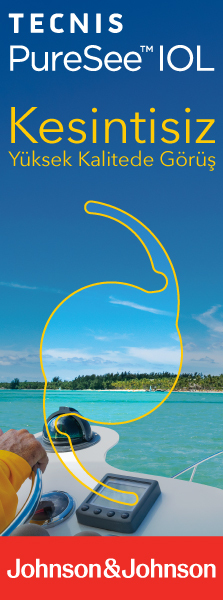TJ-CEO
2011 , Vol 6 , Num 2
Ocular Pulse Amplitude in Respect to Gender and Laterality
118 Mart Üniversitesi, Göz Hastalıkları Anabilim Dalı Çanakkale, Doç. Dr.218 Mart Üniversitesi, Göz Hastalıkları Anabilim Dalı Çanakkale, Yrd. Doç. Dr. Purpose: To evaluate ocular pulse amplitude changes (OPA) in healthy subjects.
Materials and Methods: Four hundred and two eyes of 87 males of mean age 43.9±15.8 (21-77) years and 114 females of mean age 45.7±11.7 (21-79) years, totally 201 subjects, were included in the study. Intraocular pressure (IOP) and ocular pulse amplitudes of the subjects were measured by dynamic contour tonometry (DKT) (Swiss Microtechnology AG, Port, Switzerland). IOPs were evaluated according to gender and according to right or left eye. Subjects with diabetes mellitus, hypertension, or glaucoma diagnosis were excluded from the study. Unpaired t-test and Pearson correlation analysis were used for statistical analysis.
Results: Although there was no difference between female and male subjects in terms of mean age (p=0.186) or mean IOP (18.7±3.4 mmHg and 18.3±3.2 mmHg respectively) (p=0.209), the difference between mean OPA values was statistically significant (3.4±1.2 and 2.8±1.1 mmHg), (p=0.0001). There was no statistically significant difference between IOP and OPA values (18.8±3.4 mmHg and 18.2±3.2 mmHg; 3.14±1.2 and 3.07±1.1 mmHg, respectively) among right or left eyes. While a weak positive correlation was found between age and OPA values in males (r=0.183, p=0.0001), the weak positive correlation found in females was not statistically significant (r=0.123, p=0.063).
Conclusion: As OPA value, which is thought to be an indirect indicator of choroidal perfusion, tends to increase with age, fluctuations in choroidal perfusion are likely to occur. Although no statistically significant difference was detected between OPA values of the right and left eyes, female sex and old age with higher OPA values seem more risky in terms of choroidal and optic nerve perfusion. Keywords : Ocular tonometry, glaucoma, intraocular pressure, choroidal perfusion





